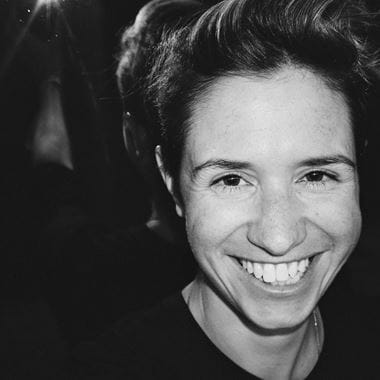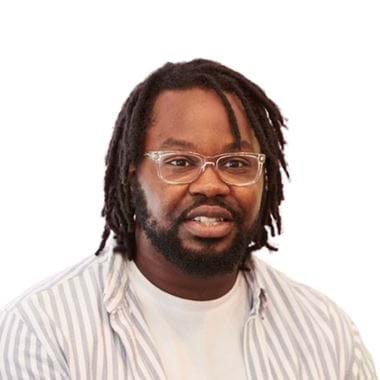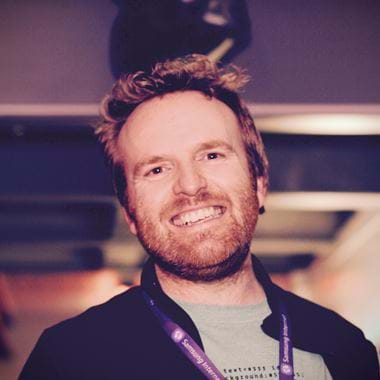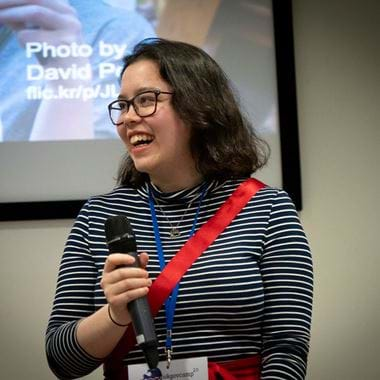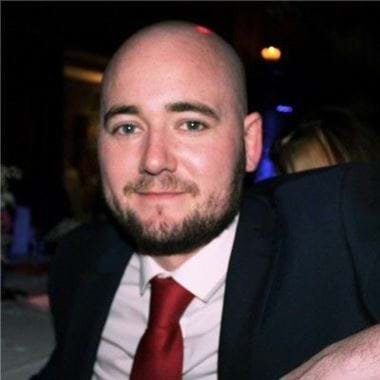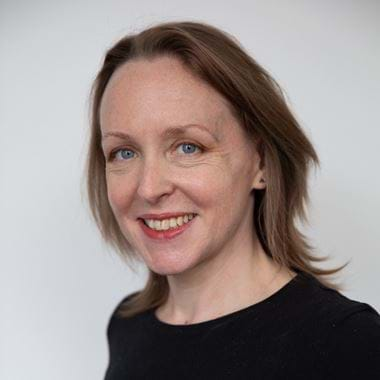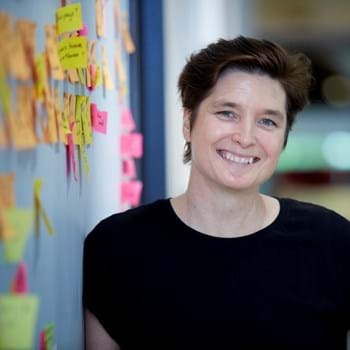
Katy Arnold
Katy Arnold is a user researcher and digital design leader. Whilst at the Home Office she built a community of 250 designers, researchers, and accessibility specialists and was accountable for the quality of their work across products and services used by millions of people.
Katy is passionate about inclusive research and design practice. She established ground-breaking research and design initiatives to support vulnerable users and oversaw projects in ambiguous and complex problem spaces with refugees and victims of modern slavery. These fed directly into service design and policy development.
Do’s and Don’ts accessibility posters. These helped establish inclusive design is a core foundation of product and service delivery.
Design Maturity: How to have impact
When we talk of design maturity we usually mean the maturity of the organisations in which we operate.
There are a plethora of maturity models, scales, and assessments which we hope will encourage organisational leaders to create the conditions for good design practice to flourish. However, by focussing purely what we’d like others to do, we risk ignoring our role in all of this.
Drawing on her experience building and leading design communities in the UK Government, Katy explores what it really means to achieve design maturity. This talk is about how to achieve genuine co-creation and how opening ourselves up to include the perspectives of others allows us to build credibility and have greater impact.
Click here to view the slides from Katy's talk
Hello, hello, hi. Can you hear me? Oh, it works, brilliant. First things first, a photograph. May I take a photograph of you and post it on Bluesky? It used to be Twitter, now it is Blue Sky. Ready, one, two, three... Brilliant. And a selfie. Is that allowed? I do this sort of thing all the time - come on, give me a wave. There you go. Thanks. Wow, hello. Thank you so much for having me here today. What an absolute honour and pleasure to be a part of such a fantastic event. Thank you for saying "legend" quick thought, we were joking back stage. What a brilliant day. I can't believe it has gone so fast. I have loved the talks. I think I am the warm-up act for the main event, Seb and the laser show later, very much looking forward to that. I have no lasers unfortunately but I'm going to talk to you about design maturity. Just to be clear, design maturity and how to have impact. Not necessarily saying, here is a spoiler, that those two things are connected as such. I'm talking about my experience of building user-centre designed team, the community and capability, at one of the most complex and large and hierarchical of the Government departments, the Home Office. And I may even tell you a bit about my design maturity journey as I grew a design capability in the department. So, it is a bit of a retrospective. I figured Madonna has her Celebration tour which came to an end this week. This is my kind of retrospective tour of my time at the Home Office. I promise I won't talk about it anymore after that. If you are new to my work, then this is a rendition of my back catalogue, you can dip into the archives later. If you have been here before, I hope you enjoy the ride. So, design maturity. Oh, it is about user-centred design, just checking you all know that. Oh, it is about user-centred design and the disciplines, specialisms of user-centred design I'm a user researcher by trade, that is my specialism. However, if you have worked in a sufficiently mature digital capability capacity or sufficiently matured digital organisation, I think this will have resonance. Let me have your feedback. I have put Bluesky and LinkedIn handles up there and I will be at the drinks later, so I would be interested to know what you think. OK, so design maturity. I'm not alone in thinking about design maturity and what it means and how to get it and how to help organisations improve theirs. A quick search on a search engine reveals a plethora of tables and charts and scales and models and levels and ladders. Everyone is thinking about it. they exist for accessibility, for digital, for agility, for user research. They are all, as I say, focussed on improving the maturity of the organisations we work with and for. In Government they are being used more frequently. This is the one from the Land Registry where they talk, a couple of years ago, 2021, they talk about design being a mindset, as well as a collection of skills. This is one from the brilliant team over at NHS, they were NHS Digital when this was created now, NHS England. I like this because it uses, you know the language isn't particularly loaded. It has that progression from no design up to designer strategy, which is where design is informing the organisational direction as well as being used in the creation of products and services. This is one we made at the Home Office. So, there is a kind of maturity model. There is a self-assessment tool, a number of indicators that we used. Me and my team put this together around 2020. That was about the time that I got my latest and final promotion in the department and became a senior civil servant. I was given the objective of making the department more design-led. That meant I was engaging with some of these really kind of quite serious programme directors and portfolio directors across the department. I have to say, I found the prospect a bit challenging. That is when I turned to a design maturity model. It was designed especially to be light touch. The reason for that was because I cared less about the rigour of the assessment, than I did about the quality of the conversation and beginning a conversation with these individuals and then keeping it going. I will talk more about that later. This is the academic section of the talk. It gets more fun later, I won't have lasers but it gets more fun. We will whizz through maturity models; I think it is quite interesting. Earliest example is the design ladder produced for the Danish Design Council, if I'm correct, in 2003. It talks about a way to categorise the different levels of levels in design houses, within an organisation, within a business. At the final step, again, you have designer strategy where the management, sorry, the executive level management of the organisation is intrinsically involved in the design process. That is what you are striving to, the peak of the maturity. I like this one because it shows the different levels but in a non-hierarchical way. Again, though, where you have got the most mature organisations is where design is integral to all aspects of the organisation. Here is another one, this is from UXPA, so no a particularly academic one but from a UX thought leader in 2010, again you have the progression up a ladder, up a scale to a corporation that is customer-driven. OK. A couple more and then we will get fun, I promise. So, some of the most influential in the UK industry have been looking at this and using quite striking language, this is an early one from Jakob Neielsen he talks about the first stages where there is hostility towards usability and where you might find developers, sorry developers in the room, talking about a good user as a dead user. I know, right. And the neanderthal attitudes of companies and management that don't understand or appreciate the value of user-centred design. And this is the model since then but the relevance to hostility still remains and again talking about the primary obstacle to maturity in an organisation is education. So, people need to be educated. Here is another one with interesting language from Tomer Sharon, from 2012. Essentially the intent behind this model was to help people understand whether they should fight for UX or flee, because you are not going to make any progress. So, fight or flee. And I like Jared Spool's lens - a true legend. His lens is that a company, an organisation has reached the sufficient level of maturity when people who don't think of themselves as designers begin to make informed design decisions. So, they know enough about the design process to begin to apply it themselves. And that, you know, that is kind of what you are aiming for. But even he talks about the dark ages. So, the first stage is the dark ages, where there is no design at all. OK. So, in summary: Almost all of the maturity models that I took a look at, talk about levels and scales and ladders. And they are all there to kind of help organisations benchmark their maturity and make progress, track their progress towards greater maturity. They are all agreed this is basically what good looks like, a mature organisation is when design is integral to how that organisation works, there is expertise at scale and in multiple places as well as at exec level.
Sophisticated feedback loops. Non-designers, like we were saying, applying proven design methods, genuine collaboration and co-creation to solve organisational challenges as well as product and service challenges. I mean I think it is quite a good thing. There is quite an interesting critique going out there, people like Erika Hall who are talking about the kind of - in some ways, all they do is benchmark and measure organisational proficiency and this actually, you know, being untethered from what is good for people is really what matters. I think it is a really good point. However, I think in essence, they are useful tools, as long as you keep in mind that they are tools, they help organisations change, they set a good standard. Don't die on a hill over them. They are simply there as tools and a framework. So, we have lots of maturity models and scales and frameworks and tools and all of this kind of great thinking. It is a lot of clever people who have put a lot of time and effort into creating those tools for us to use. Why is it still so hard? Why is it then, in our daily lives, as designers in organisations, that we are finding things to be such a struggle? I think it is because despite the rigour of those tools and scales and assessments and models, I think we have missed something. I think we have missed something really significant. And it is actively working against the outcome that we speak to achieve. Like all good talks, I have a list. So, this contains some elements of things you will find in those maturity models. Because I do think there are really good things, as I said, they are useful tools. And it also contains some elements I'm bringing to it, which is my story, as I said earlier, of design, my story of growth and becoming more mature in my application of design, as I built a design capability within the Home Office. So first, a little bit about me. This is me. About 2013. I think it looks just like me. Everybody please agree. I had some fun with Open Art AI for this illustration. And actually, I found it really hard to choose. I thought maybe that was quite a good one! I like the real dynamism, you know, grr. Couldn't get it to reproduce the word UX in it. Which I kind of wanted. This is kind of like, hot, UX hero. I would like her on my team.
This is 50snUX hero. Sultry, smoldering and at least had the UX. This is when you tell AI only to rely on my description. Clearly, I need to practice. I'm not good at that. I ended up staying with this one. I kind of liked how smug her face looks. Because that was like, it felt apt, 2013, 2014, 2015, I was smug. I was a true UX warrior, a saviour, here to save the world, I was going to save everyone. Genuinely, I was the champion of users. I had recently crossed over into UX from another discipline and I had that kind of Epiphany a lot of us do when we crossover - wow, you know, I have found a career that feels meaningful. That feels worthwhile. You might say - what is the problem of thinking of yourself as a hero in a situation, right? We can work wonders. We can get out into the world and learn about people and then turn that knowledge and that understanding into better products and services and make people's lives better. It is quite like heroic, actually. The thing is, I think that it lends itself towards a perspective which can alienate those around us and actually create a mindset which works against co-creation and collaboration and all the things that we say we are trying to achieve. But there was a really good reason why I had this mindset as well, right. This is where I worked. I left in 2022. I think it's gotten worse; it is really tough for everybody working in that organisation right now. My heart goes out to you all. Especially the amazing user-centred design community who are still there doing fantastic work. So, it is a challenging department right, it has some of the hardest, I think, policy remits around immigration and policing. And I was involved, quite early on, in doing user research on people who were interacting with the department. I saw up-close how hard it was to interact with the department and how hard it was on people. This is the user-centred design team. There were a couple of contracts and being deployed occasionally on things and broadly their approach and this is how they collected feedback from users. People used to say to us - gosh, when I tried to get in touch with the Home Office it is like screaming into the void. It's like shouting at a blank wall. Nothing comes back. And you know, some of these people that we were, we were including in our interviews and in our usability tests, they were, you know, at an extremely testing and vulnerable time in their lives. Refugees, victims of modern slavery. But even for people who were highly-educated or pretty privileged, coming from countries where they had English as their first language, they were finding the challenge of interacting and getting through to Government, sorry the department's services, so hard that they relied on immigration lawyers and immigration experts. So, there is a culture of not listening. Not wanting to hear. Not engaging. Beyond the, you know the absolute minimum that was required for policy development. It is a highly risk-averse department. They are in the news constantly. I understand that, I get it. To mean they seem super aloof, remote, determined not to invite any criticism and keen inadvertently not to make it easy for people not to apply for visas. So is it any wonder this is how I saw myself. I was working with pride. I was working with a committed team of people. They were experienced and agile and I became more and more convinced that this was how things needed to be done and the department needed to be changed. I set myself the impossible task of changing the Home Office. I don't recommend you do the same. Certainly not single-handedly, right. So, I will share some of my experiences of what that journey was like. Some stuff I got right. And obviously some of the mistakes I made. In the hope that I can help you avoid making the same mistakes.
So, 1: Do your best work. Learn your craft. Apply it, develop your methodologies. Become expert in your field, as I said, mine is user research. Become expert at that. In 2013, I think it was, yes, 2013 I was a user researcher on one of the GDF Government transformation services, I was on one of those projects, and this was a transformation programme that was aimed at transforming 24 of the highest profile Government services in the UK. Quite a few of you might be familiar with this slide and story and increasingly a high number of you may not. It was 11 years ago; I can't quite believe that. So, I worked with a team of brilliant, very experienced talented people and we used agile methods and user research and design was fully embedded into the delivery team and I loved it. Coco's talk earlier, this was a lot of fun. We made a point of having fun. I like this collection of random snapshots from the time.
As we put the service live, this is it going into its Beta phase. A very relaxed afternoon, we turned it on and watched the numbers go up. So different to what I had seen previously. I loved it. I really loved it. We did - like I said we worked on visas and I got to do some of the most interesting and compelling user research of my life. This is in Beijing in China. We went over there to test a prototype and to observe people applying for tourist visas. On the first day we popped into the visa centre where, the part of the embassy where they process the visas. And this is what we saw. Immediately, we knew that, you know, it really didn't matter what happened with the front-end of the application, this is where the real problem lay. That was my introduction to service design. And the potential that that has for radically reshaping hierarchical organisations like the Home Office. And it is a space I'm working in still. This is a Hoku book, I hope I have pronounced that right. It is an item that allows you to access healthcare and childcare in your local council area. If you don't have that physical thing, artefact, you cannot access healthcare and people are sending that in as part of their visa application process. So, if you imagine there are piles and piles of things and what it must be like to be without that really important document. So, we were deliberately disruptive and flag-waving. I remember this. We were, you know, I wasn't alone. It really felt like the cavalry had arrived, when GDS arrived, it was like - yeah, come on. And there was an army of us newly into government and charging around telling everybody how important the users were. And how they had gotten it all wrong. And if I'm completely honest, not all of us completely grasped all of it at all times ourselves. But that didn't stop us telling everyone else how to do things and how to change. So, a couple of years later, I started out a new role as Head of User Research and Design, that was my title at the Home Office. Now, it felt like I had started that role a little too early. I would say it is probably quite likely that moving into a leadership role always feels a little bit too early but genuinely in this instance it was a little bit too early for me. I had loved working with that, the product team with the visas team and loved the disruption and the sense that we were going to change the world. I probably wasn't quite ready for the step-up in maturity that this required. But I had good influences and I had good instincts. And I had access to really good blogs and people and Twitter. So, I had a really good sense that this was an important one. Be diverse in your practice. So, diverse teams create better products. A wealth of evidence behind that. So, find and hire all kinds of people and work on all kinds of problems. I was hiring a lot. I would say probably for the first year or so it was almost all I did was recruitment. And I made a point of hiring as diversely as I possibly could. A really good example of this was we set up an internship programme. I think I have seen a handful, several people here today who have been through that internship. That actually swells my heart with pride. It really does. We had an opportunity with that internship, to rethink how we were going to approach the recruitment. Because the overwhelming majority of people coming through the application process had either recently graduated, or had recently graduated from, you know at Masters' level, when it came to submitting a CV in their application form, there was very little to tell between them, to discern between them. a really bright person in my team came up with the idea of interviewing more people, let's cast the net wider. And so, even though it was much more work for us, we did, that is what we did. We interviewed something like 40 or 50% of all the applicants. Hundreds applied. What that did, we didn't know this was going to happen at the time. So this is a bit of retrospective thinking. By casting the net wider, it enabled, I guess, people to get through that might otherwise not have got through because of the inherent biases that operates and runs through any recruitment process, or that we carry around in us as human beings. We studied the numbers after two or three years and were absolutely blown away by the results. We had the, on every single factor, we were scoring significantly higher in terms of our diversity, from the crop who came through on the internship programme. And that has become such an important funnel, you know, a pipeline of talent for the team that is there today. So, it worked really, really well. Highly recommend it. A bit more work for yourself but the right thing to do. these are some snapshots from all of the user-centre, community meet-ups, we would hold them every quarter as we got bigger and bigger. I'm proud of the culture I built at the Home Office. It was there to sustain people who were then going out and working in really tough environments.
OK, as well as the cultural, the pastoral support, we also put in place all the things that are a good practice needs, so labs, participant recruitment. Help with incentives, design systems and approach to ethics, data protection, training, software and tooling support. I think this is still available on GitHub, I don't know are people making labs any more. We thought we would put it up and make it available. This is one I would recommend. We have heard about accessibility today; it is wonderful to see it running right through the soul of this conference. Highly recommend this. Build your skills and designing for all kinds of people, people with low digital skills, all the people who speak different languages, who come from different cultures and contexts. The reason for that, not only is it the right thing to do, it also benefits you as a designer and as a researcher. I'm really proud of the way that we focussed so hard on ensuring that we did this well. We really looked at how we can carry out research and design inclusively. It meant we were able to create a team now that is focussed on accessibility in the department, wrapped into the assurance teams at the moment. They are still there today and doing excellent work. And it meant that we started to learn about all the different ways that people access the internet which really benefited our designers, when it came to designing services. We had to raise our game. And so, we started to raise awareness across the department. Again a few more snapshots from some of the awareness-raising days we did and some of the hands-on training we were doing for designers and researchers. And researching people with disabilities means or meant more home visits, pre-Covid and as a result of that, we had to suddenly start considering carrying research in much more complex environments and contexts with people who are vulnerable and ensuring that you have got, you know, you think about and you consider researcher safety as well. So, as a result we set up an approach to ethics which I believe has snowballed out into other Government departments. It is still there today and it creates a bedrock foundation for the user research that is done there. But also - and it protects the user researchers - and also provides a bit of cover for the department as well. And all of this stuff was really good, right. Someone mentioned passports earlier today. All of it, was it Lou, who mentioned passports? All of this was really good. I have no doubt in my mind that that kind of really concerted effort to improve the design maturity of the department led to excellent work on Home Office services such as this one. The passport service has been turned around completely in 2014, there was a huge backlog, it was in the news. A dreadful state of affairs, delays, delays, now you can renew your passport and it is usually with you in five days, which is pretty incredible. But when Brexit happened, we were able to run some research. There was an EU ID card service, I think at the time. Nobody applied for it because they didn't need to. When the Brexit vote went the way it did, we saw a spike in people applying for this service. We took the opportunity to run real-life usability, you know, observation basically. Observing people filling out the forms for real. The longest one took eight hours. Most of that was them hunting around in their shed or bed wherever it was, trying to find the documents they were asked to provide. The traditional way that policy-makers were thinking about, when it came to operational, with their policy, was to ask people to provide a load of evidence. It was because of our research, we played them become the findings, we showed them this photo, and it was because of that that they changed the way they would ask people to confirm how long they had been in the UK and they exchange the data with HMRC. I know it was part of the policy itself and I know there were challenges with actually rolling this service out but we were able to have a really big impact on that. I think there was something like 14-18 user-centred designers working on the service by the end of it. So, yeah, I think it takes 15 minutes to run through the application to complete the whole application, it would take an average of 15 minutes. Which is pretty good. Right, our number 1 hit. The last time I was here I spoke about accessibility posters, I think they are still available. Our focus on designing for all meant that we ended up creating the posters, once our designer put them on GitHub, they went viral. Translated into different languages and turned into a book. So proud of that. So, making loads and loads of progress on many fronts in terms of pushing forward the design maturity agenda. But something wasn't right. And to explain, that I need to tell you about this one and to tell you about this one, I will give you an example of me getting it really, really wrong. Be respectful. So, around about this time, digital was merging with technology, our remit was increasing. We were coming into contact more and more with the technology programmes and projects that were being run. We came up against this issue. These are some of the lines taken from the maturity models we looked at earlier. And this is what we were coming up against, me and the heads of profession would discuss it. It wasn't UCD folk on Teams, I was coming up against this when I was trying to reach out to senior leaders across the department to persuade them of the value of design.
So, around about this time, I was asked to get closer to one of the programmes, one of the big programmes, it was the one that deals with people crossing the border and very complex, involves security, offline as well as online, it was huge and in order to pass their GDS assessment, the head of user research at GDS had told the Programme Director they had to come and talk to me. I was like quids in, I have power. At last, I'm going it make some headway, I have an in-road and I will leverage that power. So, how did I handle that conversation, do you think? Da-da!
I swooped in. UX hero. Yeah, with fanfare, music, imagine Star Wars' music in the background. it's OK, I am he here to save you, I'm going to help you. It's all right, I know you have been doing everything wrong... But I'm going it help you. I am going to save you. And I told her all about the resources I had at her disposal. The accessibility team, the digital team, the ethics, the labs, the incentives, the design system. You know, I talked a lot. And I walked away like - that went well! And I was convinced, you know, I would hear from her imminently, the next day, like, see you later. And I never heard from her again.
[Laughter]
And I e-mailed her. I even phoned her up. Completely ignored me. Totally stonewalled, the worst of it was, not only did she completely ignore me because of that behaviour, GDS, she disengaged from the whole process. So, they lost the leverage because of her. Not so good. This is a comedienne called Sarah Cooper which... It is kind of like what she looked like when I was talking to her. I was trying find something that sort of represented it. And it wasn't the only time, right, that that had happened to me. It happened lots of times, right. I would kind of make all of the effort, get some time with someone very senior and talk at them as the hero, you know the UX hero. They would do something akin to this expression. I didn't know why and I literally had no plan about what to do about it. So, about a year or so later, thereabouts, I got a great new boss. Unfortunately, it wasn't Meryl Streep. But that would be pretty amazing right. In my mind's eye, Meryl Streep, my new boss arrives. After a few weeks, sat me down and gave me really honest feedback. And the feedback was about how I was perceived amongst the other senior civil servants. Remember I was a senior civil servant. I was like two grades below the Perm Sec, quite high up. Dizzy heights up there. and he gave me brutal honesty back, if I am honest, it felt tough to take at the time. I really struggled with it. But you know what, it was the intervention I needed. I worked really hard to take it on board and reevaluate how I was approaching things. And I realised that it was, you know this mindset and my brilliant ideas and everything, was all about me, right. I was the UX hero. I was going to save everyone else. No-one else knew anything about user-centred design or digital. I knew exactly what they were doing wrong and I was here to fix it. And I was only concerned with how others should change. I was frustrated when they wouldn't. I couldn't understand why they just wouldn't - it is obvious, just do this thing I'm telling to you do. It'll work. People don't work like that. I was alienating the people I wanted to influence. I was running around talking about how I wanted to evangelise user-centred design. We all were. I didn't notice how weird that made us look. I didn't notice how weird it was that no other teammates were running around saying how important their work is and - come and let me tell you about the tasks I do and we want more influence and more say on what is happening. I desperately wanted to be brought into decision-making. I wanted that seat at the table. I wanted to be strategic. Why wouldn't they? Why wouldn't they let us in? You know, we know that our work can be a force for good, right. We want impact, don't we? Ultimately, we know that what we do helps people, right. It helps them achieve their task, apply for their thing. Navigate the machine and it feels like an inherently good thing, that is why I was drawn to this and it is why many of you were, too. The problem is that mindset fuelled the mindset of everyone else in our industry, it leads to the view that we are the educated ones and no-one else S look how we talk about people. And worse, this is a really lonely place to be. You know. It positions us as enlightened victims. As if we are passive in all of this. There is nothing we can do. They are the ones that need to change, not us. And my point is - I believe that this mindset is actively working against us achieving our aims, right. So, you don't know everything. Ideology helps no-one in practice. Standards are things we work towards rather than always achieving. So be humble, be pragmatic, be adaptable.
What happened to our empathy? I thought we were supposed to be good at this, right. What happened to being human-centred? We are dogmatic instead of pragmatic. We are idealistic, instead of realistic. We are berating those around us who don't know the terminology and don't understand what UCD means or user testing in the wrong way. Isn't it time we developed a little bit of compassion and understanding? Isn't it time we developed some humanity. We can't all be designers, right. In most organisations design decisions are happening everywhere all the time, and you can't control them all. You can't.
And we need developers to be specialist at what they do. We need policy-makers and business change and BAs, to be experts at what they do. And we need to be specialists about what we do. They need us to be specialists at what we do. And we need to work together, right, collaboration. So, this is also about you. Because the thing that is missing from the maturity models and scales and ladders and charts is your design maturity and by that, I mean your maturity of approach. Your maturity, your outlook. It is about being comfortable with others having agency in the design process, this is about composure, generosity. Respect for those around you. 6: Make friends and influence people. OK, this is nothing new, right. And it's how your work can have a greater impact. There are ways to be intentional about this and I will show a couple of things to wrap up. Trust, I have heard the word "trust" about 15 times today in various talks and events today. Trust is so important. When people trust you, they listen and respond. They decide to work with you and they take action. They come on your side. In the work that I do right now, I'm involved in digital transformation work right now, this is the single thing that comes up more than anything else. Trust. So, how do we build trust? Well, lucky enough, some wonderful bright academics have come up with a formula. This is how it goes. So, if you think about credibility is that you are professional expertise, can you, you know, can you do what your skillset says you can do. Reliability, are you dependable, will you do what you say do you? Intimacy, what is it like to work with you? And you can score like full works, one-to-five, five being top. You can score full marks right between the top but if your self-orientation is too high, people will trust you less. And your self-orientation is people's perceptions of your focus. So, do people believe that you care more about your agenda, than you do about theirs? Social capital, anyone heard of social capital? Yeah, thank you. So, I first heard about it when I did my first degree, sociology here in Manchester, really nice to come back. I was reminded it by a wonderful leadership coach who worked with me and my team recently. Social capital is the fabric of every social interaction and relationship you have. The good news is that you can think carefully about how you build it and construct it and maintain it, in order to build those kind of trust relationships with people in your team, fast. And not just people in your team but people in your working environment. And the best way to do that, to build the trust and build out your networks is to listen. The very thing I didn't do earlier, right. And when I say "listen" I mean really listen. Really take the time, really observe and really show the person that is in front of you, that you care, that you care genuinely about their world and their problems and what is happening to them. And how do you demonstrate you are listening? Ask questions that focus on their world. Mirror their body language, mirror their words. Reflect back emotional content. Don't assume, check your understanding. Summarise to show that you actually have listened. This is, like, proper hard work listening. If only I knew a discipline that was quite good at this sort of thing? We do have a superpower. Oh my God. Who knew? We have an actual superpower. We are experts in this. We do this all the time. We create environments of psychological safety and ask people to tell us honestly how things are for them, including if it is not going well. We are just not using it with the people we work with, or with the senior leaders in our organisation, or the people-leading programmes. Those design maturity models we looked at earlier, we talk about power and impact and measuring progress. How organisations need to change, the design maturity I'm talking about, is about confidence, composure, generosity, respect. Because I believe this can be a superpower and this is how you bring people with you. This is how you land the value of user-centred design and influence what work is done as well as how well work is done. Do you remember this person? So, there is a conclusion to the story because about three years later she joined the senior leadership team I was part of. I was slightly awkward at first. Because suddenly we were peers. And I started - when she joined the team - I was now in full-on listening practice mode. Trying to develop these skills. So, I was quite different with her. She opened up quite quickly. I don't know, in a couple of weeks she completely opened up with me and she said: Do you know why, do you know why I never let you. Why that happened? She said - because GDS came in and you never backed me up. You threw me under a bus. You were supposed to be in the Home Office, you were supposed to be on my side and an external organisation came in and you hung me out to dry. She said - I decided that day I was never going to let you anywhere near my programme. And then she said, now you are like a completely different person. Of course I wasn't. I was the same person, I still think all those same things, I still have that passion, I still want to change the world. But my behaviour was different. Intentionally differently. Different in a way that was focussed on ensuring I could build a trusting working relationship with somebody, based on respect, right. And since then, and between this time and the time that I left the Department, we made significant strides forward in terms of design maturity in the department. We set up a policy design lab which has moved into the strategy department of the organisation, it is no longer even in digital data and technology. So, sitting right up there with the strategy folk. We hired principles to work with strategic-centred design, so there were practitioners at a senior level in the department. We were able to establish the accessibility standards PSBAR as a tool, digital data and technology standard. These are really massive steps forward. I really believe it is because we changed our mindset and approach and decided to operate with more humility, respect and, I guess, maturity. So, there you go. Six ways to build your design maturity. Three you can find in the design maturity models. The last three are the ones that I think will show that you are able to operate at a senior level and will increase the impact that your design prowess deserves. Thank you very much.
